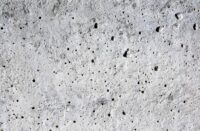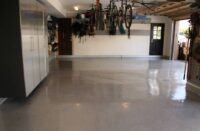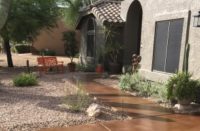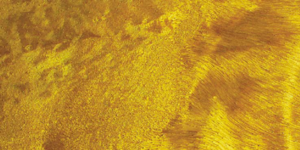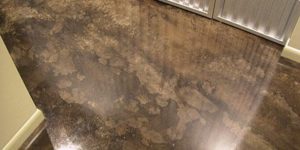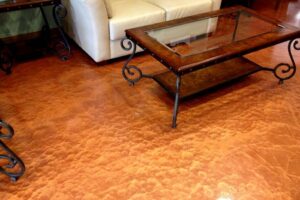
Do you love the look of acid staining but could do without its unpredictable outcome and predictable mess? Would you like to pour floors that exquisitely mirror objects without any polishing? Finally, do you wish you had a way to achieve a consistent three-dimensional look with the same color (or colors) time after time?

If you answered yes to any or all of the above, you may find metallics attractive. More and more contractors, business owners and consumers across the nation are discovering the variegated beauty, dazzling shine and depth of coatings made possible with metallic and metallic-like pigments.
Today’s metallic-looking coatings vary in composition. Some don’t contain metal and are largely mica or synthetic mica particles coated with colors. Others contain aluminum pigments, various metals and liquid colorants. Some boast a complex combination of the aforementioned ingredients. But they all have one thing in common. “They all provide drift and sparkle in different ways depending on how light hits them and on the angle of viewing,” says Gary DeBoer, technical director with Westcoat Specialty Coating Systems.
Metallic coatings are being used all over the country and throughout the world, perhaps more in metropolitan areas with larger populations. The coatings can be found everywhere from nightclubs, restaurants and car dealerships to doctors’ offices, hair salons and high-end retail stores where durable surfaces are needed and a contemporary look is desired.
Besides the private garages of car aficionados and serious collectors, metallic floors also are popping up in celebrities’ residences, with celebrities such as Vanna White reportedly wild about the Cafe Dazzle in her home theater in Beverly Hills.

Interest is growing
Ask the manufacturers and distributors of metallic coatings if the use of their products is on the rise and you’ll get an emphatic “yes.”
The reasons are many, including the fact they are so easy to use and the color palette is so broad. These days, higher-grade metallics are dispersing better and creating a deeper 3-D look. Epoxies flow more proficiently, many self-level, and they don’t have nearly as many bubbles as in years past. They are also clearer and are less likely to amber. The pot life has been extended and the drying time is faster without compromising the integrity of the coating. There’s a quicker turnaround time for the installer than in years past, with less labor involved. And metallic coatings can be a less-expensive and viable alternative to overlays and stains for floors in bad shape.
“It’s a niche business,” says Westcoat president Paul Koury, whose company introduced Liquid Dazzle four years ago. “In the last four to five years, we’ve seen increased interest. The beauty of the product is it can produce a variety of colors on a seamless epoxy floor that’s chemical-resistant, easy to clean and durable. And on the food side, it meets USDA criteria for flooring.”
“I think we’ve seen a surge of interest in metallic coatings because you get an acid stain look that’s controllable in a 20-mil coat of epoxy,” says Ken McKinnon, president of McKinnon Materials, which makes Aurora Epoxy Dust Concentrate in 12 standard colors. With dust-size pigment particles suspended in translucent epoxy, “you also get a deep mirror look that is simply beautiful,” because the pigments reflect light instead of absorbing it.
The real beauty of metallic products, he adds, is how easy they are to install and how easy it is to duplicate results. “We can show you a sample of our Aurora dust in our epoxy and that’s the way it’s going to look on your floor,” unless you opt to manipulate it by blowing, raking or troweling it.
Application is simple
Although the effects produced by metallic coatings look advanced, installation is quite simple. Most manufacturers suggest you profile and prep the floor with a primer of some sort, with some recommending a light sanding once the primer dries. Next, you spread the self-leveling metallic coating with a trowel, roller or squeegee in a random back-and-forth motion so as not to create lines. At this point, you could be done … or you could put on spiked shoes, go onto the floor and trowel, squeegee, roll, spritz with a solvent or even blow the epoxy around the floor to redistribute the pigments that create the metallic look.

Don’t assume that all of these techniques will get good results with every metallic. For example, McKinnon doesn’t recommend spraying alcohol on an Aurora surface. “While you’ll get the pigment to move, it won’t move all the way to the bottom. It will just move on the surface. If you get a blemish and had to sand it down, you’d end up sanding away part of the swirl.”
Finally, some products on the market today require a sealer, while others do not.
“We’ve been able to produce a coating with a high gloss, so we eliminated the need for a smelly urethane to give it more shine,” says Tonino Zaccagnini, director of operations for EpoxyMaster, which manufactures more than 20 premixed custom-colored epoxy kits in the metallic category. “What was once viewed only in exotic car paints now can be achieved in exotic floors. It takes epoxy flooring beyond the normal.”
Thanks to metallics’ consistency and controllable attributes, says Matthew Newman, president of Versatile Building
Products, “the concrete substrate is no longer the determining factor of the end color achieved. With metallics, you can get the same results, the same color (regardless of where you are). I so wish metallics were available when I was acid staining.” It’s also a much more environmentally friendly product, with little to zero VOCs, he adds.
 Choices abound
Choices abound
There are dozens of metallic-type products on the market today you can use to add color to clear epoxies, polyaspartics, polyurethanes and even acrylic sealers. Most of the products are primarily designed to be used with epoxies.
Some companies, such as McKinnon Materials, Increte and Elite Crete Systems, sell powdered pigments along with their epoxies as part of a kit. Others, like Cohills Building Specialties Inc., sell metallic pigment packets that can be added to your coating of choice. And still others — such as Westcoat, Key Resin, EpoxyMaster and Concrete Solutions — premix the metallics into part of a two-component epoxy system.
Versatile Building Products, which has been manufacturing Lava Flow since 2008, recently switched from premixing pigment into an epoxy component to offering it as a color pack that can be purchased seperately. “It gives the product a longer shelf life,” says company president Newman, “and it allows us to better control inventory.” Lava Flow, which requires a vapor-stop primer but not a topcoat, comes in 11 colors.
 Koury notes Westcoat continues to premix Liquid Dazzle. “We developed a metallic process for our epoxy system and ended up with something better than we hoped for,” he says. The company has even coined a term, “dynamic drift,” to describe how the pigments swirl, flow and melt together.
Koury notes Westcoat continues to premix Liquid Dazzle. “We developed a metallic process for our epoxy system and ended up with something better than we hoped for,” he says. The company has even coined a term, “dynamic drift,” to describe how the pigments swirl, flow and melt together.
“You just have to be sure you pour Liquid Dazzle thick enough so the drift will occur while it’s setting up,” Koury says.
To produce Liquid Dazzle’s 16 colors, the company uses “a broad mix of metallic pigments and liquid colorants,” says DeBoer, and combines them in a controlled environment. “The biggest thing about Liquid Dazzle is its consistency. It takes some of the error out of the equation for the installer.”
Elite Crete Systems, a leader in the metallics coating business since 2007, has always offered its Reflector Enhancer in a powder form. “We believe it offers greater versatility to the installer,” says Mario Nicasio, in charge of market development and technical support. “You can use it in our epoxy or any of our clear sealers or industrial topcoats to get a different effect.
“Our product mottles automatically,” he says. “It won’t look the same 20 minutes after you first put it down because the floor continues to move without your spraying solvents or using air.”
Elite Crete director of technical engineering and market development Ken Freestone notes that Reflector Enhancer colors achieve the dimensional effect in one of two ways — some are true metallic particles and some are multiple sizes of similarly colored nonmica particles.
Reflector Enhancer is usually used as an opaque in 100-percent solids epoxy, Nicasio says. “From a distance it looks like stained or polished concrete, but as you get closer you’ll see 3-D mottling with metallic shimmers.” To create a semitransparent look, you can apply a pigmented epoxy base coat and cover that with a Reflector coat that has less of a load.
In waterborne epoxies, the look is usually more translucent because they are generally applied thinner. With a polyaspartic medium, Nicasio says, there’s still mottling, but colors will separate differently as the coating begins to thicken, creating more of a reptilian-scale look in areas. Polyaspartics also offer superior chemical and abrasion resistance and is 100 percent UV stable. Still, he doesn’t recommend using it outdoors as it’s a nonbreathable coating. Instead, he suggests using Elite Crete’s CSS Emulsion, which is an MMA-laced high-solids acrylic sealer.
Brett LaFevers, regional sales rep for Cohills Building Specialties — a company that offers a whopping assortment of 42 different colors—says you typically won’t get as dramatic an effect with a polyaspartic coating as you will with 100 percent solids epoxy. But the upside is that a polyaspartic allows a floor to be put back into service much quicker.
The same holds true for the polyurea product introduced by Citadel Polyurea Coatings in June 2011.
Pearlescent Metallic solution, which the company boasts is “as strong as the metal it mimics,” is reportedly 20 times stronger than epoxy. This product features iridescent powder tints combined with the company’s single-component polyurea to produce marbleized floor coatings with gleaming high-gloss finishes.
Unlike most other metallic-type coatings, which are only intended for indoor use, Pearlescent Metallic is UV-stable and can be used for outdoor projects as well. It claims a four-to-eight-hour walk-on time and a 24-hour return-to-service time, even with multiple layers.

Manipulation Techniques
While most metallic coatings on the market will produce a variegated look just by applying them, you can do a number of things to enhance their appearance. “They can be manipulated with air and denatured alcohol to give you a rippled and mottled effect,” says Bart Sadleir, general manager for Concrete Solutions (part of Rhino Flooring Corp.), which makes Metal Fusion in 11 standard colors. All you need is a solvent-resistant pump-up sprayer and a cordless blower, he says.
“You also can add concrete dye mixed with acetone and fog that over the surface to achieve additional color variation,” he says. Or you can just stick with one color and use air or solvent to get different tones in the coloring.
According to Versatile Building Products company literature, using a looped paint roller or a notched trowel when first applying the product produces a more uniform appearance, while a pool trowel or metal squeegee leave a more mottled, flowing look.
After the coating has begun to set up, some companies recommend using a basic pump sprayer filled with a dispersing agent, which is usually denatured alcohol, to backspray the surface. A light spray will produce a more uniform pattern while a heavier dose will leave a pattern that looks more sporadic. Different solvents produce different results, but in general the larger the drops, the bigger the craters the solvent will form. If you don’t like the look the backspray has made, you have 15 minutes or more where you can trowel or squeegee the surface and try again.
“Alcohol is just a weight that moves the metallic and creates the mottling effect,” says Newman.
Koury says Westcoat has developed a coloring system called Dazzle Effects that combines multiple colors of Liquid Dazzle — sometimes including Fast Stain, the company’s concrete dye, in the mix — so the colors swirl and drift into each other to form dynamic patterns. Although the company doesn’t offer specific training classes on the technique, there are videos available on both Liquid Dazzle and Dazzle Effects, as well as informal training clinics in some locations.
